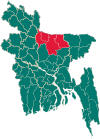Khaliajuri Upazila
History
Until the middle of the fourteenth century AD, the Bhati Rajya (Khaliajuri and surrounding areas) was the capital of Kamarupa. In the fourteenth century, a Kshatriya monk named Jitari invaded and occupied Bhati Rajya. Another Kshatriya monk named Lambodar came took over the rule of Bhati in the twelfth century. Nagendranath Basu asserts that Lambodar and Jitari may have been the same person.
In the 16th-century, Khaliajuri was home to a Bengali Hindu man called Shitanath Om. His three sons; Raghunath Om, Kamakhya Om and Maheshnath Om, later found employment under Khwaja Usman of Bokainagar, a Baro-Bhuiyan chief who had control over large parts of Greater Mymensingh. Following the defeat of Raja Subid Narayan of Ita by Khwaja Usman and his allies which included the Om family, the Om brothers migrated to Satgaon in Sreemangal, Sylhet where they were given jagir.
In 1906, a thana (police outpost) was established in Khaliajuri. Khaliajuri Thana's status was upgraded to upazila (sub-district) in 1983 as part of the President of Bangladesh Hussain Muhammad Ershad's decentralisation programme.
Geography
Khaliajuri is located at 24°42′00″N 91°07′30″E / 24.7000°N 91.1250°E. It has 12903 households and total area 297.64 km (114.92 sq mi). It is bounded by Mohanganj and Jamalganj upazilas on the north, Itna upazila on the south, Sulla and Derai upazilas on the east, Madan upazila on the west.
Demographics
According to the 2011 Census of Bangladesh, Khaliajuri Upazila had 18,903 households and a population of 97,450. 29,211 (29.98%) were under 10 years of age. Khaliajuri has a literacy rate (age 7 and over) of 30.39%, compared to the national average of 51.8%, and a sex ratio of 957 females per 1000 males. 6,193 (6.36%) lived in urban areas.
As of the 1991 Bangladesh census, Khaliajuri had a population of 75,801. Males constituted 52.31% of the population, and females 47.69%. This Upazila's eighteen up population is 39,052. Khaliajuri had an average literacy rate, of 21.5% (7+ years), and the national average of 32.4% literate.
Administration
Khaliajuri Thana was formed in 1906 and it was turned into an upazila in 1983.
Khaliajuri Upazila is divided into six union parishads: Chakua, Gazipur, Khaliajuri, Krishnapur, Mendipur, and Nagar. The union parishads are subdivided into 54 mauzas and 75 villages.
| Name | Term | Notes |
|---|---|---|
| Muhammad Abdus Shahid Chowdhury | 7/11/1983-24/5/1985 | In-charge |
| Abdul Jalil Chowdhury | 25/5/1985-29/12/1987 | |
| Muhammad Muinuddin | 14/1/1988-14/2/1988 | In-charge |
| Qazi Nurul Islam | 15/2/1988-17/7/1988 | In-charge |
| Siddiqur Rahman Taluqdar | 17/7/1988-24/5/1990 | |
| Haji Zaynul Abidin | 28/5/1990-22/11/1990 | In-charge |
| Abdul Mannan Taluqdar | 23/11/1990-23/11/1991 | |
| Ghulam Kibria Jabbar Krishnapuri | 4/3/2009-1/4/2014 | |
| Muhammad Shamsuzzaman Taluqdar Shuayb Siddiqi | 2/4/2014-10/2/2019 | |
| Ghulam Kibria Jabbar Krishnapuri | 10/4/2019-present | 2nd term |
Notable people
- Mustafa Jabbar, inventor of the Bijoy Bengali keyboard which was formerly the most widely used Bengali input method
- Mohammad Hadis Uddin, 23rd Inspector General of Bangladesh Police
- Om family, historic family
See also
Gallery
-
Prakash Nath Public High School
References
- ^ National Report (PDF). Population and Housing Census 2022. Vol. 1. Dhaka: Bangladesh Bureau of Statistics. November 2023. p. 401. ISBN 978-9844752016.
- ^ "Bangladesh Postal Code". Dhaka: Bangladesh Postal Department under the Department of Posts and Telecommunications of the Ministry of Posts, Telecommunications and Information Technology of the People's Republic of Bangladesh. 20 October 2024.
- ^ Chanda, Jiban Kumar (2012). "Khaliajuri Upazila". In Sirajul Islam; Miah, Sajahan; Khanam, Mahfuza; Ahmed, Sabbir (eds.). Banglapedia: the National Encyclopedia of Bangladesh (Online ed.). Dhaka, Bangladesh: Banglapedia Trust, Asiatic Society of Bangladesh. ISBN 984-32-0576-6. OCLC 52727562. OL 30677644M. Retrieved 11 January 2025.
- ^ Majumdar, Kodarnath. ময়মনসিংহের ইতিহাস [History of Mymensingh] (in Bengali). p. 15.
- ^ Basu, Nagendranath. Bangla Bishwakosh বাংলা বিশ্বকোষ [Bengali Encyclopedia] (in Bengali).
- ^ Choudhury, Achyut Charan (1917). (in Bengali) (first ed.). Kolkata: Kotha. pp. 252–53 – via Wikisource.
- ^ Population and Housing Census 2022 - District Report: Netrokona (PDF). District Series. Dhaka: Bangladesh Bureau of Statistics. June 2024. ISBN 978-984-475-237-5.
- ^ "Community Tables: Netrokona district" (PDF). bbs.gov.bd. 2011.
- ^ "Bangladesh Population and Housing Census 2011 Zila Report – Netrokona" (PDF). bbs.gov.bd. Bangladesh Bureau of Statistics.
- ^ "Population Census Wing, BBS". Archived from the original on 2005-03-27. Retrieved November 10, 2006.
- ^ "District Statistics 2011: Netrokona" (PDF). Bangladesh Bureau of Statistics. Archived from the original (PDF) on 13 November 2014. Retrieved 14 July 2014.
- ^ "Previous Chairmen". Khaliyazuri Ufozela (in Bengali).

